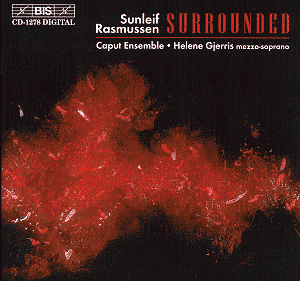Until quite recently, the Faroe Islands were much better-known
as a remote archipelago lost in the icy Arctic waters rather than a musical
nation. Some may recall a Faroese tune used by Grainger in Letís
Dance in Green Meadows for piano duet and by Nielsen in his atmospheric,
though rather slight An Imaginary Journey to the Faroes.
Now, thanks to the tireless vitality of a Mighty Handful of Faroese
composers (Kristian Blak, Atli Petersen, Pauli
Ū Sandagerđi, Edvard Debess and Sunleif Rasmussen) whose music placed
the Faroes on the contemporary musical map, things have changed considerably.
With some background in jazz and improvised music,
Sunleif Rasmussen went to Copenhagen and studied with Ib Nørholm
and Ivar Frounberg, and later at IRCAM in Paris where he got in touch
with some "spectral" composers such as Tristan Murail and
Ė presumably Ė the late Gérard Grisey. Rasmussenís early works
were still influenced directly by Faroese folk music which he used in
his own way, whereas his more recent output, of which the present release
presents a fairly comprehensive survey, displays a more wide ranging
palette incorporating some modern techniques, such as spectral harmonies,
while still borrowing from Faroese folk music and hymns, often used
as a basic idea transformed beyond recognition. Some of his music has
already been available in commercial recordings, such as his beautiful
Landiđ for soprano
and orchestra (on TUTL FKT 7) and his wind quintet Cantus Borealis
(on BIS CD-1086). His recent, large-scale First Symphony Oceanic
Days (the first Faroese symphony ever), that still awaits its
first recording, was awarded the Nordic Councilís music prize in 2002
and may be considered as the most ambitious synthesis of Rasmussenís
musical thinking so far.
The pieces recorded here are all fairly recent and
clearly belong to Rasmussenís maturity. In spite of their diversity,
they all are clearly from the same pen and share many common characteristics.
Also noteworthy in Rasmussenís musical make-up is the importance of
the writings of William Heinesen (1900 Ė 1991). The title of the First
Symphony is actually taken from a poem by Heinesen, whereas both vocal
pieces recorded here, actually movements from an 8-movement work-in-progress,
are settings of poems by Heinesen. Tilegnelse ("Dedication")
and Arktis are quite beautiful, atmospheric, imaginatively
scored pieces for mezzo-soprano and small ensemble that augur well for
the rest of the forthcoming cycle that will hopefully be completed soon.
It is interesting to note that some material in Tilegnelse
is the reworking of some material from a symphonic work The Song
of the Sea (this is heard in the seascape music of the introduction).
Mozaik/Miniature (flute, clarinet, violin
and piano) is another example of Rasmussenís practice of reworking material
from other pieces of his (in this case, from the opening of the First
Symphony) and again alternates folk like tunes and hymns that are the
basis of the symphony though, as already mentioned, the borrowed material
undergoes complex transformations so that the actual music is actually
anything but folksy.
Similarly Trauer und Freude ("Sorrow
and Joy") is based on the first phrase of the similarly titled
hymn. It is scored for wind quintet, string quartet, piano/harpsichord
and guitar. Its three movements reflect the titleís dialectic implications:
Sorrow and Joy in the first movement, Sorrow in the sad,
slow central movement and Joy in the lively, virtuosic Finale.
Again, there is much imaginative writing here, albeit often of a rather
austere sort. It is the most ambitious piece here.
Surrounded for small chamber orchestra
is another substantial piece also in three movements (actually a long
central Cantabile framed by two shorter, livelier movements).
Again, it makes use of some existing material, in this instance the
first phrase of a Norwegian folk tune (Surrounded by Enemies).
The title also aptly reflects the instrumental layout of the piece in
which the string quartet is surrounded by the rest of the ensemble.
There is much dialogue and interplay between the strings and the other
instruments, in a variety of ways, so that the piece might be experienced
as some sort of concerto grosso in modern guise. Once again,
the music displays many Rasmussen hallmarks. A quite substantial piece
of music and one of the finest and most impressive here anyway.
Rasmussenís is a quite distinctive voice in Nordic
music and this generous, well-planned and superbly played cross-selection
of his recent output is most welcome. I hope that the First Symphony
will soon be recorded, and that other similar releases of Faroese music
will soon be available from the same source. Recommended.
Hubert Culot

